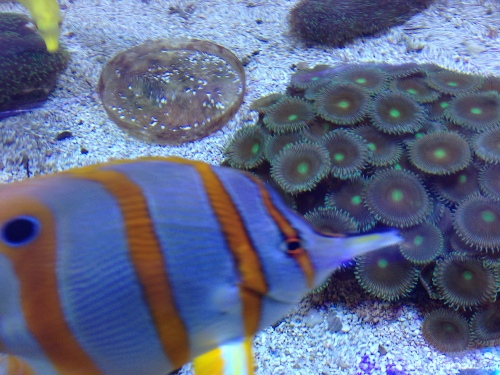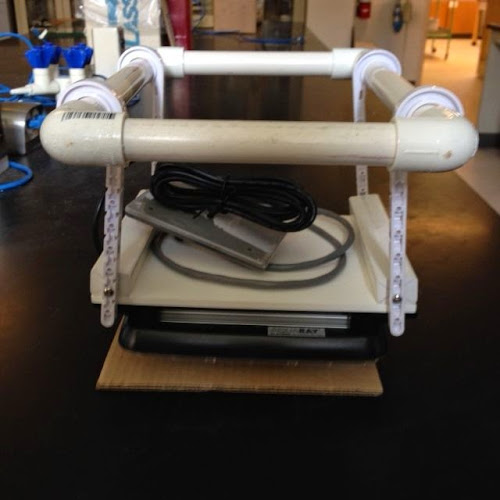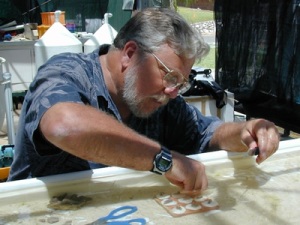Our friend from St. Mary’s has updated us on the progress of their experiment. Best to just quote what he said.
—
“We are done
The research report has been submitted as a senior thesis and is on file in our library.
I am planning to add a Marine microcosm sustainability page to my web site and I will upload the complete study to that page as well as an annotated the version for a general (but marine aquarium savy) audience as well as the abstract of the study abstract.
St Mary’s College is proud of their “Green campus ” awards so the page will focus on “Sustainable Science” from the viewpoint of natural resources (the reefs) materials (the actual microcosm) and energy usage.
Synopsis
The soft corls (Sarcophyton) show no statisticaly significant difference with respect to the light source. The paper explains how this may result from the difficulty in obtaining reproucible samples.
The Zooanthid (Playthoa) and hard coral (Galaxia) however did show statissticaly significant improvement in growth of the coral ans well as the zooxanthallae count and chlorophyl content.
The web site will include facility description and brief synopsis of the research conducted. I will include photos. Bottom line: there is statistically significant scientific evidence that the hard coral and zooanthid tested will show improve growth and health with LED illumination. We present energy use statistics to indicate a dramatic reduction in energy use and of course increase in the sustainability of marine microcosms using solid state lighting.”
Above is the Thesis and Abstract of the experiment done by Dr. Hatch’s students. They specifically look at three different lighting types and compared growth. There was significant difference between the variables!
These studies will be linked to from this blog as soon as they are received!
—

My opinion, which is in no way the end all for the reasoning of this experiment.
Dr. Hatch came to know the LEDs he choose for this experiment, by understanding the TMC AquaRay LED line is a brand advertising, they use less watts to get quality growing energy. Some claims, is that there will be more growth, because the spectrum in the fixture are selective, licensed, and patented. As a base line, even if these 30 watt fixtures can go the same as another 120 watt LED, or 250 watt MH… The fixture is doing it with only 30 watts.
The statement can be made, watt per watt, for LEDs available to date, these LEDs have the most useful amount of energy. As in, growth was increased compared to VHO and MH at only 30 watts of quality light spectrum.
Was this experiment testing LEDs compared to other LEDs… No.
There’s really no need for this study as there are so many variables (different spectrum and amount of spectrum) which can affect the experiment. There’s no benefit for someone running a large LED study like this.
120 watts LEDs could have been included in the experiment to add another variable, but there are so many combinations of 120 watt fixture, some included user features like dimming, so what would it really proved?
How are these fixtures different? It’s in the way they drive the energy from the fixture. Emitter didoes can be designed to be under driven or driven at a certain voltage. Many 120 fixtures use many emitters and under drive them. Some less watt fixtures drive their emitters at a higher voltage, but use less emitters.
What this study does shed light too, is that even with 30 watts of high output LEDs (of known useful growth spectrum, not color spectrum), growth will be better than VHO and MH. Certain corals at that (interesting how it’s the “higher light” requiring corals at that, not the soft corals, known for requiring less light. Growth maxed out?) As all different species of plants and corals, could grow different under different spectrum or require different amounts of light.
The spectrum being provided for this experiment, was focused on Chlorophyll Synthesis of Chlorophyll A & B. Color was a moot point as it was not the focus of the study. Even though, color was not an issue, which we can see from pictures. So, with 30 watts of high powered LEDs, great color is still present, which many people question.
More info on PAR/PUR and Chlorophyll Sysnthesis
Great job Dr. Hatch and students. Looking forward to the journal review of the experiment.








